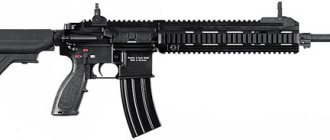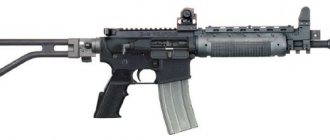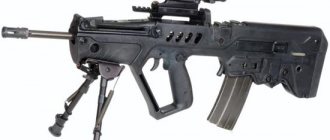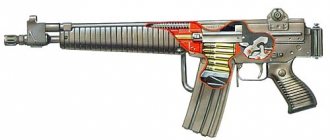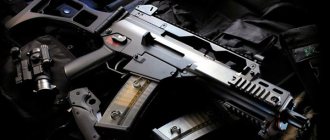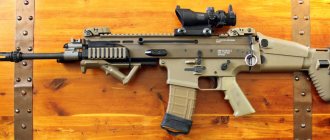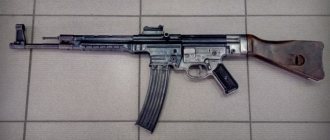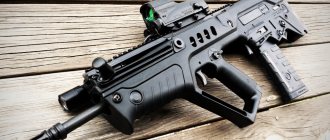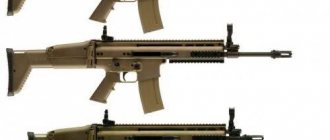Description
The AR-18 rifle, the production of which began in the USA, was planned to replace the NATO AR-16 model, only with a 5.56 caliber. The designers of the model wanted to create a cheap and simple weapon that could compete with the Kalashnikov assault rifle in 3rd world countries.
The AR-18 model has an interesting history. We can say that its release came at the wrong time. The entire arms market has already been divided between the Kalashnikov assault rifle and the M-16 rifle. In 1967, Japan purchased a license for mass production of the rifle. Japanese AR-18s were not produced for long; the Japanese government did not want to indirectly get involved in the conflict in Vietnam, so Howa Machinery Co stopped producing AR-18s in 1974.
The barrel of the machine gun and the box are made of stamped steel. The main method of joining parts is spot welding and stud joints. The design of the model provides for replacing the magazine with 30 and 40 rounds. The portable belt is attached to the bottom of the barrel and to the end of the handle. This fastening does not interfere with folding the stock.
Design
The operating principle of an automatic rifle is based on the energy of powder gases. When the gunpowder ignites, the resulting gases begin to press on the piston. After the shot, the gases push the piston back. Through a system of complex mechanisms, it retracts the bolt frame. In this case, the bolt allows the empty cartridge case to fly out and sends a new cartridge into the chamber. At the end of the cycle, the weapon is ready to fire automatically. The rifle can fire single shots and a burst.
Performance characteristics
The Armalite AR-18 was planned as an inexpensive and reliable weapon for third world countries. The engineers fully justified their goal. It took 28 parts to assemble armalite. The rifle is quickly assembled in makeshift conditions.
- country of origin: USA
- weight with empty magazine: 3.09 kg
- weight with full magazine: 3.58 kg
- bullet speed at departure: 1000 m/s
- weapon length without stock: 736 mm
- weapon length with butt: 940 mm
- barrel length: 464 mm
- sighting range: 400 m
- number of rounds per minute: 800
Automatic (assault rifle) Armalite AR-18 (USA)
Original AR-18 rifle produced by Sterling Armaments (UK)
The AR-180B rifle, revived in 2002, differs only in the self-loading mechanism and the plastic lower part of the receiver
Cross-sectional diagram of the AR-18 (from the original patent issued in 1968 to Sullivan, Miller, and Dorchester, developers of the AR-18)
Caliber
: 5.56×45 mm (M193)
Type:
Gas-operated automatic, locking by turning the bolt
Length
: 940 mm (738 mm with the stock folded)
Barrel length
: 464 mm
Weight
: 3.09 kg with an empty 20-round magazine
Rate of fire
: 800 rounds per minute
Power supply
: 20, 30 or 40 round detachable box magazines
Development of the new AR-18 assault rifle was begun by Armalite in the early 1960s, after Armalite's parent company, Fairchild Corporation, sold all rights to the AR-15 rifle to Colt in late 1959. The development of the new rifle was led by three leading Armalite employees who remained after the departure of Eugene Stoner - George Sullivan, Arthur Miller and Charles Dorchester. The first prototypes of the rifle were ready by 1963. The AR-18 rifle was deliberately developed taking into account the simplest and cheapest technologies, which made it possible to launch its production even in less developed countries, since the Armalite company planned to sell licenses for the production of this rifle. The AR-18 was also tested by the American military, and successfully, but the US Army at that time had already opted for the AR-15/M16 rifle, and there was simply no place left for the generally quite successful AR-18 rifle in its class on the global arms market, divided between the American M16 rifle and the Soviet Kalashnikov assault rifle. However, Armalite managed to sell licenses for the production of the AR-18 and its semi-automatic civilian version, the AR-180, to the UK (to Sterling Armaments) and to Japan (to Howa Machinery Co). The total production of AR-18 series rifles, according to various sources, ranged from 10 to 20 thousand units, and by 1979, production of the AR-18 was completely discontinued. However, twenty years later, the reorganized Armalite company announced the resumption of production of the civilian modification of the AR-18 under the designation AR-180B. The new rifle is almost identical in appearance to the “original” AR-18, but it also has a number of differences. Firstly, it can only fire single shots. Secondly, the AR-180B stock is awkward, and thirdly, the lower part of the receiver is made of plastic molding, integral with the pistol grip. The trigger mechanism also differs from the “native” AR-18, and is borrowed from rifles of the AR-15 type, produced under the designation M15 by Armalite itself. Serial production of the AR-180B rifle has been established since 2002.
Despite the commercial failure of the AR-18 project, this rifle served as the basis for a number of other weapons. Firstly, the notorious English SA-80 system is largely a “bulged” AR-18, and at the same time severely spoiled by the low quality of design and production. Secondly, AR-18 designer George Sullivan developed the SAR-80 rifle at the Singapore company CIS, which also has significant similarities with the AR-18. Well, and finally, the relatively new German G36 rifle from Heckler-Koch also has considerable similarities in its internal structure with the AR-18.
AR-18 device. The AR-18 rifle is built on the basis of an automatic gas engine with a short stroke of the piston located above the barrel. The gas piston is made in the form of a glass, covering the outlet pipe of the gas chamber, and has its own return spring. The barrel is locked by a rotating bolt, similar in design to the M16 bolt, and locked behind the receiver. The rectangular bolt frame moves inside the receiver on two guide rods, each of which has its own return spring. The bolt rotates using a pin moving in a shaped groove cut into the wall of the bolt frame. The bolt group, along with the guide rods and return springs, is assembled into a single module using front and rear end panels, and is removed as a single unit when disassembling the weapon. The cocking handle is rigidly fixed to the bolt frame on the right and moves when firing. The slot in the receiver for movement of the bolt handle is closed with a spring-loaded cover. The mechanism provides for stopping the bolt in the open position when all the cartridges in the magazine are used up (bolt lag).
The AR-18 receiver is made of two halves - upper and lower, made from stamped steel sheet. The halves are connected at the front by a hinge, which allows the receiver to be “broken” for access to the bolt group and trigger mechanism. The rear ends of the bolt frame guide rods serve as the receiver latch.
The AR-18's trigger mechanism is hammer-operated and provides single-shot and burst fire. The safety lever—the fire mode translator—is located on the left of the receiver and is similar to the translator on the M16.
The AR-18's handguard, pistol grip, and side-folding stock are made of black plastic. The sling swivels are located on the base of the gas chamber under the barrel (front) and on the base of the pistol grip (rear), so that the position of the sling is independent of whether the stock is folded or not. Sights include a front sight in a semicircular muzzle on the base of the gas chamber and a reversible “L”-shaped diopter rear sight on the receiver. In addition, all AR-18s are equipped with mounts for proprietary optical sights on the upper surface of the receiver.
Modifications
There are several modifications of the rifle. The AR-18S carbine features a short barrel and a flash suppressor. The carbine is equipped with a second handle for ease of shooting. The optimal sighting range reaches 330 m. The carbine pierces a steel NATO helmet from a distance of 300 m.
Since 2002, it has been producing the AR-180B version, specifically for security services and police. The AR-180B fires single rounds from a 20-round magazine. The bolt and trigger mechanism is based on the AR-15 rifle produced by Armalite. The modification has one drawback - the butt does not fold.
—Footnote— The Irish Republican Army brought worldwide fame to the “little armalite.” During the armed struggle with Britain, the rebels purchased an American machine gun. The song about “baby armalite” became the anthem and symbol of freedom for the IRA.
Modern weapons companies have appreciated the AR-18. It served as a template for the SAR-80 rifle from the Singaporean company CIS. The Japanese Type-89 and the German G-36 are partially copies of the Armalite.
Background
| This section may contain original research . |
Shortly after the adoption of the 7.62×51mm NATO M14 rifle in 1957 by the US Army, the Continental Army Command (Conarc) began investigating the small caliber, high velocity (SCHV) rifle as an offshoot of the military's existing research program, Project SALVO. ArmaLite and Winchester Arms approached CONARC to provide prototype automatic rifles chambered for the .22 high-velocity round. The Armalite AR-15 was a smaller version of the 7.62 AR-10, which arrived too late to be a serious contender against the M14 for adoption by the US Army. Its competitor was the Winchester .224 lightweight rifle.[10] Williams' "Carbine" prototype carbine design was in .22 high velocity, around which was similar to, but not interchangeable with, the .223 Remington (5.56×45mm). During the lengthy US military testing of the AR-15, ArmaLite Fairchild's corporate owners abandoned the design and sold the AR-15 manufacturing rights to Colt. Fairchild also spun off ArmaLite as an independent company, allowing the new owners to purchase all of the company's designs except the AR-10 and AR-15. When the US military eventually selected the AR-15 over the M16, ArmaLite could no longer profit from its adoption.
The Armalite AR-16 appeared in the later 1950s. The AR-16, a 7.62mm NATO selective fire rifle, was Eugene Stoner's latest design for ArmaLite. The AR-16 and its predecessor, the AR-12, were developed by Stoner in response to demands from the militaries of smaller, less developed countries for a less expensive but modern selective fire military rifle that, unlike the AR-10 and AR-15, could be inexpensively manufactured from thick sheet metal on automatic screw machines, lathes and presses. [11] [12] The AR-12 originally featured a direct impingement (DI) gas system, but this was now replaced by the more traditional short-stroke gas piston in the AR-16 after ArmaLite sold the rights to manufacture the DI system to Colt Firearms. [11] The AR-16 had a short 15-inch barrel, a hinged wooden stock, and weighed 8.75 pounds unloaded; A total of three copies were built. [12] Eugene Stoner left ArmaLite in 1961, shortly before Fairchild lost ownership. [13]
The US Military's later adoption of the AR-15 gave legitimacy to its 5.56mm cartridge, and ArmaLite sought to develop a competing design chambered for the 5.56mm cartridge that did not violate Colt's licensing agreement. Following Stoner's departure, it was decided to scale down the AR-16, and ArmaLite's new chief designer, Arthur Miller, began the project. The result was a 5.56 mm design in 1963 called the AR-18. Miller was later awarded US Patent 3246567 for the rifle in 1969.
Users
- Botswana[38]
- Japan - Produced as Howa Type 89 Assault Rifle.[6]
- Malaysia - Used during the Communist Insurgency War.[22]
- Swaziland[23]
- United Kingdom - Used for informational purposes only.
- United States - Used for informational purposes only.
Non-government users
- Provisional Irish Republican Army[39]
- Lebanese Forces Militia - Used in small numbers by commando units[ citation needed
]
References
- ^ab "Historical Review of Armalite, Page 5" (PDF). Armalite,
Inc. January 4, 2010 Archived from the original (PDF) on July 7, 2011. Retrieved June 2, 2011. "It is particularly interesting to note that the later RSAF 5.56mm rifle, the SA-80 (later adopted as the L85) was nothing more than a bullpup version of the AR-180." - https://www.gunmart.net/militaria/article/armalite_sterling_ar-18_5.56mm_rifle “if you ever take apart an SA80 or see a picture of one completely disassembled, then take a close look at the bolt and gas system, as it is almost a direct copy of the old one AR-18 systems »
- https://www.guns.com/news/2016/03/17/armalite-ar18-rifles-eugene-stoners-redheaded-stepchild-love-redheads/ “When the ArmaLite Model 18 was in its final days of production, Enfield weapons engineers largely borrowed its design for “inspiration” when creating their new 5.56 mm rifle. Known then as the Enfield Weapons System and now as the L85, the British Armed Forces bullpup rifle is a modified AR18 thrown into a radically different stock."
- "Archival copy". Retrieved November 1, 2014. “Borrowing a page from their Commonwealth partner, the Singapore SAR80/SR88 rifles have the same action as the AR18. However, the British got it right, with both the Austrians and Germans also using similar short-stroke gas piston designs on the Steyr AUG and HKG36 rifles."
- McCollum, Ian (December 24, 2012). "FS2000 on the range". Forgotten weapons
. - ^ab "89式5.56m小銃" (in Japanese). Archived from the original on 2008-12-24. Retrieved January 17, 2009.
- https://www.smallarmsreview.com/display.article.cfm?idarticles=2974 “But the true legacy of the AR-18 is all of the “modern” firearms that use bolt carriers and operating systems like the H&K XM8 & G36 , Bushmaster/Remington ACR, FN SCAR 16/17, South Korea Daewoo K1/k2, British L85A1/SA80, and Singapore SAR-80/SAR-88"
- "Unlimited AR in Canada AR180B". Silvercore Firearms Training. Archived from the original on September 24, 2015. Retrieved May 25, 2014.
- Jump up
↑ Wharton, Kenneth (2011).
Bloody Belfast: An Oral History of the British Army's War against the IRA
. History Press. ISBN 9780752475981. - "Winchester .224 E2 manual". January 28, 2011
- ^ ab Smith, W.H.B. and Smith, Joseph E. (eds.) Small Arms of the World
, 9th ed., Harrisburg, PA: The Stackpole Company, ISBN 978-0-81171-566-9 (1969), pp 656 - ^ abcde Walter, John, Rifles of the World
, Iola, WI: Krause Publications, ISBN 978-0-89689-241-5 (2006), p. 42 - Pikula, Sam (Major), ArmaLite AR-10
, Regnum Fund Press (1998), ISBN 9986-494-38-9, page 92 - ^ abcde Hogg, Ian and Weeks, John, Twentieth Century Military Small Arms
, 6th ed., Northfield, IL: Digest Books Inc., ISBN 0-87349-120-3 (1991), p. 181 - Dolazell, Harry, 5.56mm ArmaLite/Sterling AR-18 Rifle
, Colchester, Essex (UK): GunMart Magazine, Aceville Magazines Ltd. (2000) - ^ab Cutshaw, Charles, Return of the AR-180
, Guns Magazine, Vol. 49, No. 6 (June 2003): In addition to random stock vibration, on some AR-18 rifles the upper receiver may wobble up and down relative to the lower receiver. - https://www.smallarmsreview.com/display.article.cfm?idarticles=2974 "Armalite AR-18/AR-180 Rifles: The Rifle That Never Could" by Christopher R. Bartocci
- "ARMALITE AR-180 - Tactical Life Gun Magazine: Gun News and Gun Reviews".
- Danilo Lazo and Juanita Mercader. AFP Self Defense Defense Program (SRDP): Leading the Nation to a New Direction (PDF) (Report). item 151. Archived (PDF) from the original on 2015-10-04. Retrieved October 3, 2015.
- ^ ab Ballistic Research Laboratory, Aberdeen Proving Ground, AR-18 Rifle Kinematic Evaluation, Cal.
0.223 , Philadelphia, PA: Frankford Arsenal (undated) (unclassified) - "ArmaLite AR-18/AR-180 Rifles". www.smallarmsreview.com
. - ^ ab "Sterling Armalite AR-18K". Firearms Blog. November 21, 2012
- ^ a b Bishop, Chris. Weapons in battle
. Chartwell Books, Inc. (1998). ISBN 0-7858-0844-2. - Patrick, Derrick (1981). Bring on Felix: the fight against the Ulster bombers, 1976-1977
. Hamish Hamilton. paragraph 32. ISBN 978-0-241-10371-5. - "Wolfhound". www.theballadeers.com
. - MacDonald, Henry; Cusack, Jim (2004). UDA: at the heart of the Loyalist terror. Penguin Ireland. item 121. ISBN. 978-1-84488-020-1. Retrieved May 19, 2013.
- "ArmaLite Sterling AR180 SCS .223 Thumbhole Target Stock". gunpartscorp.com
. Archived from the original on 2011-07-11. Retrieved June 2, 2011. - ^ a b "ArmaLite AR-18: Widowmaker". weaponryonline.com
. Archived from the original on March 17, 2011. Retrieved June 2, 2011. - https://www.helstonforensics.com/wp-content/uploads/2018/05/STERLINGS-TURN-WITH-THE-ARMALITE-AR-18-AR-180.pdf
- Gun Digest, 1994 Annual Page 160
- McCollum, Ian (March 30, 2020). "Ross Rudd delayed-recoil AR180 prototype". Forgotten weapons
. - "ArmaLite, Inc. AR-180B rifle". cruffler.com
. Archived from the original on June 7, 2011. Retrieved June 2, 2011. - "NoDak Spud AR-180 Receivers". www.nodakspud.com
. - "AR-180B Standard Adapter Type 1". StormWerkz
. November 19, 2012 - Oladyi, Daniil (January 7, 2019). "KODIAK DEFENSE WK180-C: BEST SELLING BLACK RIFLE?" .
- "Brownells releases new take on old design: BRN-180". AmmoLand.com
. January 28, 2022. - "Brownells BRN-180 | The best source for firearms reloading equipment, accessories and tools is Colt." www.brownells.com
. Retrieved April 25, 2022. - "Botswana procurement of Ar-18 rifles". November 5, 1976 - via WikiLeaks PlusD.
- Dillon, Martin (1991). Dirty War
. Books with arrows. item 430. ISBN 0-09-984520-2.
